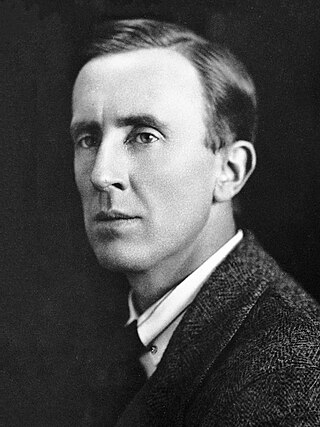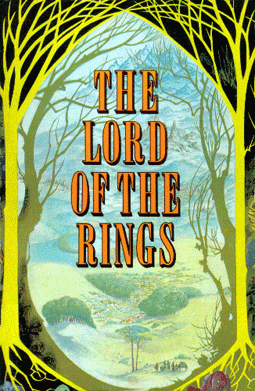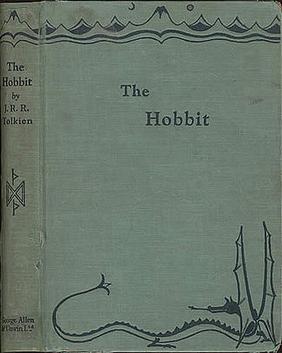
Jane Johnson (born 1960) is an English writer of books for adults and children and fiction book editor. As a writer she has used the pseudonyms Gabriel King, jointly with M. John Harrison, and Jude Fisher, as well as her real name. [1] [2]

Jane Johnson (born 1960) is an English writer of books for adults and children and fiction book editor. As a writer she has used the pseudonyms Gabriel King, jointly with M. John Harrison, and Jude Fisher, as well as her real name. [1] [2]
Jane Johnson was educated at Liskeard Grammar School. She has a first class honours English degree, a teaching degree and a master's degree in Old Icelandic language and literature. [3]
From 1984 to 1992, she was the editor responsible for the J.R.R. Tolkien list at George Allen & Unwin Publishers and commissioned both John Howe and Alan Lee to illustrate Tolkien's work, including Lee's acclaimed illustrated Tolkien-centenary edition of The Lord of the Rings. The publishing house was later bought by HarperCollins, where she remains a Publishing Director working remotely across the Voyager fantasy and science fiction list and crime/thrillers. [4] Her authors there have included George R.R. Martin, Raymond E. Feist, Robin Hobb, Dean Koontz, Stuart MacBride, Jonathan Freedland, Tom Knox as S.K. Tremayne, and Mark Lawrence.
With M. John Harrison she wrote the four-volume "Gabriel King" series [5] – the "Tag, the Cat" animal stories as catalogued by ISFDB (1997 to 2002). [1] The series is available in e-book in the UK and are still in print in the US.
As "Jude Fisher", she worked with cast and crew to create six Visual Companion books (2001 to 2014) for the film trilogies The Lord of the Rings and The Hobbit , Peter Jackson's adaptations of Tolkien.
Johnson travelled to North Africa in 2005 to investigate a family legend about the abduction of a family in 1625 from a Cornish church by Barbary pirates, and there met Abdellatif, who was later that year to become her husband, a Berber tribesman. She now splits her time between the UK and a small town in the Anti-Atlas Mountains. Her first adult mainstream novel was The Tenth Gift, based on the Barbary pirate story. This was followed by a desert epic, set in the Sahara among the Tuareg nomads, The Salt Road. The Sultan's Wife (2012) is set in the 17th-century court of Sultan Moulay Ismail and tells the story of two slaves, an African chieftain's son Nus-Nus and an Anglo-Dutch woman Alys. It also includes an account of the embassy sent from the Moroccan sultan to the court of King Charles II which is documented in John Evelyn's Diary . Her novels are translated and sold in more than 20 countries.[ clarification needed ]. Living part of the year in Morocco, Johnson has made good use of her acquired knowledge of Moroccan culture and history as a background for the novels. In 2016 her 12th century epic, Pillars of Light, set largely inside the walls of Acre during the infamous siege during the Third Crusade was published by the University of Central Lancashire to considerable critical acclaim, and was published in paperback in 2022 by Head of Zeus. It was described by Anne Fortier as 'A masterpiece of historical fiction', and by historian Dan Jones as 'Epic and tender, as thrilling as it is moving... deftly spins a story of the crusader world that is rich, deep, complex and quite unlike anything I've read before.' The following year her account of the Fall of Granada – Court of Lions was published by Head of Zeus in the UK, Penguin Random House in Canada and by Pegasus in the US. The Sea Gate – a WWII story set in her native Cornwall – was published by Head of Zeus in summer 2020 in the UK, and in winter 2020/21 by Simon & Schuster in Canada and the US. The White Hare, an eerie tale set in Cornwall in 1954, was praised by Jackie Morris (The Lost Words, Spell Songs) as a novel that ''sings of an earth alive with power' and by Liz Fenwick as 'A brilliant novel of love, loss, forgiveness, and healing...' It is released in the US and Canada in October 2022. Her latest novel is The Black Crescent, set in Morocco in 1955 as the struggle for independence from the French Protectorate comes to a head. The Sunday Times selected it as one of the historical novels of the year and called it 'a compelling narrative'.
Her magical fantasy novels for children include The Eidolon Chronicles (Legends of the Shadow World in a US omnibus edition): The Secret Country, The Shadow World and Dragon's Fire.Two single volume stories followed: Maskmaker in 2010 and Goldseekers in 2011.
For children:
For adults, four novels set in Morocco:
one novel set in Syria"
one novel set in Spain
Two novels set in Johnson's native Cornwall
This series of animal stories by Johnson and M. John Harrison as Gabriel King was published by Century (British hardcover editions) and other Random House divisions. [1]
all were reissued by Head of Zeus in 2017.

John Ronald Reuel Tolkien was an English writer and philologist. He was the author of the high fantasy works The Hobbit and The Lord of the Rings.

The Lord of the Rings is an epic high fantasy novel by the English author and scholar J. R. R. Tolkien. Set in Middle-earth, the story began as a sequel to Tolkien's 1937 children's book The Hobbit, but eventually developed into a much larger work. Written in stages between 1937 and 1949, The Lord of the Rings is one of the best-selling books ever written, with over 150 million copies sold.

The Hobbit, or There and Back Again is a children's fantasy novel by English author J. R. R. Tolkien. It was published in 1937 to wide critical acclaim, being nominated for the Carnegie Medal and awarded a prize from the New York Herald Tribune for best juvenile fiction. The book is recognized as a classic in children's literature and is one of the best-selling books of all time, with over 100 million copies sold.
The Nazgûl, introduced as Black Riders and also called Ringwraiths, Dark Riders, the Nine Riders, or simply the Nine, are fictional characters in J. R. R. Tolkien's Middle-earth. They were nine Men who had succumbed to Sauron's power through wearing Rings of Power, which gave them immortality but reduced them to invisible wraiths, servants bound to the power of the One Ring and completely under Sauron's control.

Bilbo Baggins is the title character and protagonist of J. R. R. Tolkien's 1937 novel The Hobbit, a supporting character in The Lord of the Rings, and the fictional narrator of many of Tolkien's Middle-earth writings. The Hobbit is selected by the wizard Gandalf to help Thorin and his party of Dwarves to reclaim their ancestral home and treasure, which has been seized by the dragon Smaug. Bilbo sets out in The Hobbit timid and comfort-loving, and through his adventures grows to become a useful and resourceful member of the quest.

Bag End is the underground dwelling of the Hobbits Bilbo and Frodo Baggins in J. R. R. Tolkien's fantasy novels The Hobbit and The Lord of the Rings. From there, both Bilbo and Frodo set out on their adventures, and both return there, for a while. As such, Bag End represents the familiar, safe, comfortable place which is the antithesis of the dangerous places that they visit. It forms one end of the main story arcs in the novels, and since the Hobbits return there, it also forms an end point in the story circle in each case.
The Red Book of Westmarch is a fictional manuscript written by hobbits, related to the author J. R. R. Tolkien's frame stories. It is an instance of the found manuscript conceit, a literary device to explain the source of his legendarium. In the fiction, it is a collection of writings in which the events of The Hobbit and The Lord of the Rings were recounted by their characters, and from which Tolkien supposedly derived these and other works. The name of the book comes from its red leather binding and casing, and from its having been housed in the Westmarch, a region of Middle-earth next to the Shire.
"The Scouring of the Shire" is the penultimate chapter of J. R. R. Tolkien's fantasy The Lord of the Rings. The Fellowship hobbits, Frodo, Sam, Merry, and Pippin, return home to the Shire to find that it is under the brutal control of ruffians and their leader "Sharkey", revealed to be the Wizard Saruman. The ruffians have despoiled the Shire, cutting down trees and destroying old houses, as well as replacing the old mill with a larger one full of machinery which pollutes the air and the water. The hobbits rouse the Shire to rebellion, lead their fellow hobbits to victory in the Battle of Bywater, and end Saruman's rule.
The Notion Club Papers is an abandoned novel by J. R. R. Tolkien, written in 1945 and published posthumously in Sauron Defeated, the 9th volume of The History of Middle-earth. It is a time travel story, written while The Lord of the Rings was being developed. The Notion Club is a fictionalization of Tolkien's own such club, the Inklings. Tolkien's mechanism for the exploration of time is through lucid dreams. These allow club members to experience events as far back as the destruction of the Atlantis-like island of Númenor, as narrated in The Silmarillion.
The following outline is provided as an overview of and topical guide to the real-world history and notable fictional elements of J. R. R. Tolkien's fantasy universe. It covers materials created by Tolkien; the works on his unpublished manuscripts, by his son Christopher Tolkien; and films, games and other media created by other people.
The works of J. R. R. Tolkien have served as the inspiration to painters, musicians, film-makers and writers, to such an extent that he is sometimes seen as the "father" of the entire genre of high fantasy.
Do not laugh! But once upon a time I had a mind to make a body of more or less connected legend, ranging from the large and cosmogonic to the level of romantic fairy-story... The cycles should be linked to a majestic whole, and yet leave scope for other minds and hands, wielding paint and music and drama. Absurd.

The Tolkien family is an English family of German descent whose best-known member is J. R. R. Tolkien, Oxford academic and author of the fantasy books The Hobbit, The Lord of the Rings and The Silmarillion.
The Hobbit is a 1968 BBC Radio adaptation of J. R. R. Tolkien's 1937 children's fantasy novel of the same name.

The History of The Hobbit is a two-volume study of J. R. R. Tolkien's 1937 children's fantasy novel The Hobbit. It was first published by HarperCollins in 2007. It contains Tolkien's unpublished drafts of the novel, with commentary by John D. Rateliff. It details Tolkien's various revisions to The Hobbit, including abandoned revisions for the unpublished third edition of the work, intended for 1960, as well as previously unpublished original maps and illustrations drawn by Tolkien.
Frodo Baggins is a fictional character in J. R. R. Tolkien's writings, and one of the protagonists in The Lord of the Rings. Frodo is a hobbit of the Shire who inherits the One Ring from his cousin Bilbo Baggins, described familiarly as "uncle", and undertakes the quest to destroy it in the fires of Mount Doom in Mordor. He is mentioned in Tolkien's posthumously published works, The Silmarillion and Unfinished Tales.

The Fellowship of the Ring is the first of three volumes of the epic novel The Lord of the Rings by the English author J. R. R. Tolkien. It is followed by The Two Towers and The Return of the King. The action takes place in the fictional universe of Middle-earth. The book was first published on 29 July 1954 in the United Kingdom. The volume consists of a foreword, in which the author discusses his writing of The Lord of the Rings, a prologue titled "Concerning Hobbits, and other matters", and the main narrative in Book I and Book II.

Tauriel is a fictional character from Peter Jackson's feature film adaptation of J. R. R. Tolkien's The Hobbit. The character does not appear in the original novel, but was created by Peter Jackson, Philippa Boyens, and Fran Walsh as an expansion of material adapted from the novel. She appears in the second and third films in that trilogy, The Hobbit: The Desolation of Smaug and The Hobbit: The Battle of the Five Armies.
Tolkien's Middle-earth family trees contribute to the impression of depth and realism in the stories set in his fantasy world by showing that each character is rooted in history with a rich network of relationships. J. R. R. Tolkien included multiple family trees in both The Lord of the Rings and The Silmarillion; they are variously for Elves, Dwarves, Hobbits, and Men.
J. R. R. Tolkien used frame stories throughout his Middle-earth writings, especially his legendarium, to make the works resemble a genuine mythology written and edited by many hands over a long period of time. He described in detail how his fictional characters wrote their books and transmitted them to others, and showed how later in-universe editors annotated the material.

Tolkien's Art: 'A Mythology for England' is a 1979 book of Tolkien scholarship by Jane Chance, writing then as Jane Chance Nitzsche. The book looks in turn at Tolkien's essays "On Fairy-Stories" and "Beowulf: The Monsters and the Critics"; The Hobbit; the fairy-stories "Leaf by Niggle" and "Smith of Wootton Major"; the minor works "Lay of Autrou and Itroun", "The Homecoming of Beorhtnoth", "Imram", and Farmer Giles of Ham; The Lord of the Rings; and very briefly in the concluding section, The Silmarillion. In 2001, a second edition extended all the chapters but still treated The Silmarillion, that Tolkien worked on throughout his life, as a sort of coda.